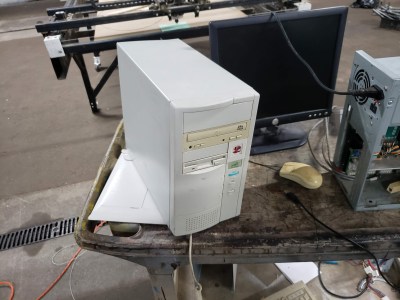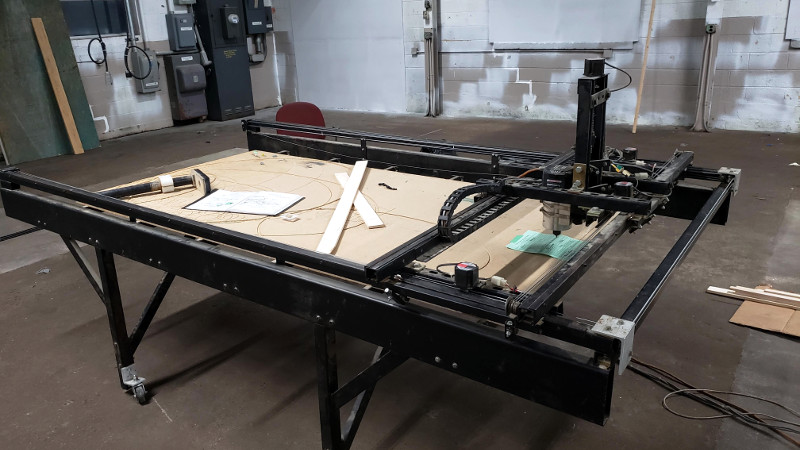Large machine tools are often built to last a very long time, so it is not uncommon to find a lathe made in the 19th century still providing faithful service. The fundamental job of a lathe has not changed significantly in the intervening years, even though a modern lathe will have more features than its hundred-year-old equivalent.
 This is not the case for CNC machine tools. When computer numerical control was wedded with old iron machine tools, the control hardware was doomed to quickly become antique or vintage. From the user interfaces to the control circuitry, in the world of electronics new features quickly become obsolete. [Evan] has a ShopBot CNC wood router from the mid 1990s that he describes as an antique, and his tale of its restoration is both a fascinating look at the changes in small-scale CNC control over two decades as well as something of a primer for anyone considering a similar upgrade.
This is not the case for CNC machine tools. When computer numerical control was wedded with old iron machine tools, the control hardware was doomed to quickly become antique or vintage. From the user interfaces to the control circuitry, in the world of electronics new features quickly become obsolete. [Evan] has a ShopBot CNC wood router from the mid 1990s that he describes as an antique, and his tale of its restoration is both a fascinating look at the changes in small-scale CNC control over two decades as well as something of a primer for anyone considering a similar upgrade.
The controller is a pair of beige-box PC cases that scream “I love the 90’s!”. One contains a socket-7 PC running Windows 95, and the other houses the ShopBot controller; an 80c32 dev board with ShopBot firmware, coupled to a set of motor controller boards, which unlike today’s controllers expect raw quadrature inputs. His aim was to replace the vintage hardware with a modern alternative. An Arduino Mega running grbl to talks to the ShopBot controllers by way of a small piece of electronics to condition quadrature data from the step and direction lines it provided. The result may not be as good as a router from 2019, but it did save this aging tool from retirement.
















If anyone else is faced with the same problem of needing anything other than step-dir then it might help to know that LinuxCNC can output a variety of step patterns. Either quadtrature, up/dwn or for exciting the motor coils directly:
Quadrature is step type 2 here:
http://linuxcnc.org/docs/2.8/html/hal/rtcomps.html#_stepgen
The same patterns are supported by the hardware step generators too, in the event that sending pulses out of the parallel port is considered a bit too retro.
Say what you want but Windows 95 was a perfect RTOS for CNC and other real-time mission-critial control application. Later editions like XP, 7 or IIS were broken by design kludges with NT kernel that did not allow direct hardware control.
Windows 95 is not nor has ever been a RTOS. Besides the fact that its classification as an operating system is debatable, it’s a multi-tasking environment using a preemptive scheduler. Anything but real-time.
As for direct hardware access: Thank god modern editions don’t support it. Sure, it’s nice if you don’t feel like writing drivers, but it’s an immense security hole and makes for a very unstable operating system. Not to mention a plethora of compatibility issues between devices.
Windows 98 Second Edition was much better. Software, especially old DOS CNC control software, could still grab exclusive port access. With any of the NT based Windows versions you don’t get that. Windows will periodically seize control of COM and LPT ports, breaking the continuous data stream monitoring most old DOS control software needs.
I have an old ProLight PLM 2000 benchtop bed mill. (With its up to 100 pound working load there has never been a mill of its size with that kind of capacity.)
It has an Animatics servo control box that gets fed G-Code through a serial connection. The control software only feeds it code and monitors signals from the Animatics box for hitting end stops, the e-stop being hit, motor over torque etc. Neither ProLight nor Intelittek ever bothered to write Windows software for this model, despite producing it for most of the 80’s and 90’s. The DOS software saw few updates and requires EMS RAM in order to load larger G-Code files, or they have to be split and chaining commands added to load in chunks that will fit available RAM.
But for the lower cost, less sophisticated PLM 1000 with stepper motors, ProLight did write Windows software.
But can it play Doom, urm wait yes it can.
There are several boards on the market for controlling steppers and or servos. Software license is quite affordabel and there are some freeware programs….
Which software licenses would you recommend for this?
Hmm, not quite an Antique as that would require it to be over 100 years old. Not really Vintage either as that as a rule of thumb is 50 years old.
There is however great benifits from collecting Vintage and Antique equipment. Although often its not as fast or as automated as more modern machines if they have been kept in reasonable condition you can get them for a song and they often have really impressive percision. not to mention the things are often bullet proof.
A couple of years ago (close to 10) I got a large CNC router running again by replaceing the rather large custom controller with a system from Planet CNC. At the time they published the circuit and firmware for a PIC based controller, simple enough to build on a bit of vero board – connect the stepper drivers and off you went.
The board I hacked together was only intended as a test to see if the rest of the machine was useable- I believe my vero board construction is still doing the deed.
https://planet-cnc.com/hardware/
Hmm doesn’t look like they have the schematics any firmware listed any more :-(
Back when small, general purpose computers didn’t have the power to quickly handle complex computations like circular arc interpolation from a center, radial distance from center, angle of start and end points – CNC required specialized controller computers with all the calculation programming built in.
Operation was done using a monitor and control panel (or just some LEDs, perhaps a numerical display, and control panel) on or near the machine. Some had a serial port to be ‘drip fed’ one to a few G-Code lines at a time from a general purpose computer, usually a DOS PC but software could be written for pretty much any computer if you had the communications protocol information.
Then came CNC machines integrating a PC running Windows or a proprietary OS, but still mainly as a feeder of code to a dedicated machine controller, whether self contained or on an expansion card. One maker of CNC punch presses integrated a Macintosh IIci with a custom NuBus control board into their lower priced models.
In recent years it’s been a common thing to take old CNC machines, strip off all the old, slow and outdated electronics then replace it all with a common PC and an interface between the computer’s parallel port and the machine’s original motor drivers – if the motors themselves haven’t also been replaced with newer ones.
In either case it’s often possible to have the old iron doing tricks impossible with the original control system.